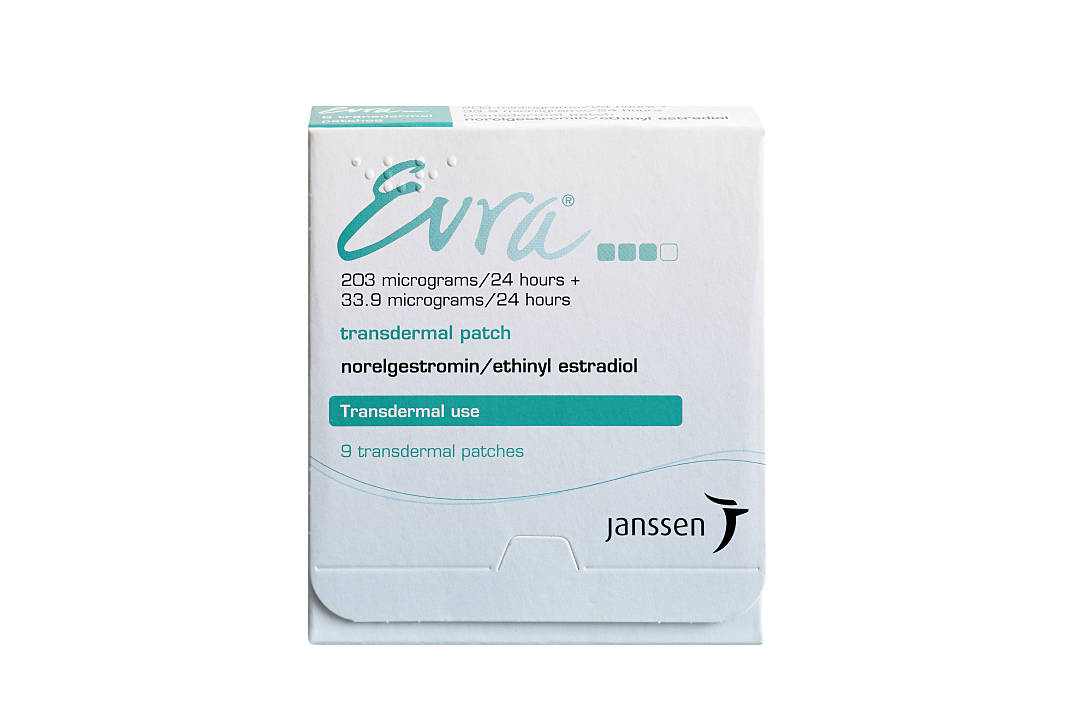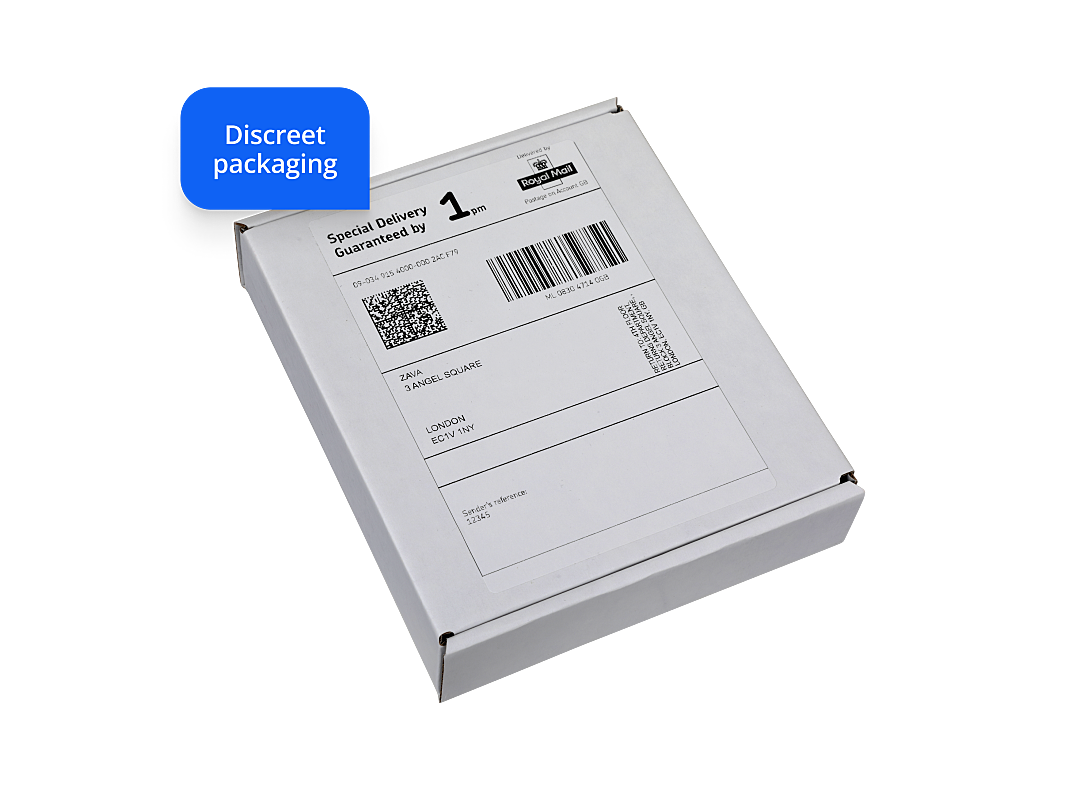





Prices from £33.99
In stock. Simply fill in a brief consultation questionnaire and one of our doctors will review your request today.
-
The Evra contraceptive patch is an effective, safe and simple way to protect yourself against pregnancy. You can use an Evra patch instead of taking the contraceptive pill.
You only need to change your Evra patch once a week, unlike the contraceptive pill which you have to take once a day. After using Evra patches for 3 weeks, you should have a 7 day break then start applying them again.
Evra is just as effective as the combined pill because it also contains 2 types of female sex hormones:
- ethinylestradiol (an oestrogen)
- norelgestromin (a progestogen)



About Evra
-
-
The Evra birth control patch is a combined hormonal contraceptive method that you can use to prevent pregnancy. It contains the hormones ethinylestradiol and norelgestromin which, when taken correctly, stop you from getting pregnant.
The Evra patch comes in the form of a sticker which you put on your skin. You absorb the hormones through your skin and they pass into your bloodstream. Once in place, an Evra patch releases around 203 micrograms of norelgestromin and 33.9 micrograms of ethinylestradiol each day.
What is the Evra patch used for?
The Evra patch is used to stop you getting pregnant. If you use it correctly, it’s very effective; up to 99%. So, of 100 women using the patch each year, only 1 will get pregnant. It’s a simple, easy-to-use contraceptive option.
What are 3 benefits of using the patch?
The patch:
✓ Is simple to use
Once you have put the patch on, you don’t have to think about it for another week. You can have sex without interruption, don’t have to remember to take a pill at the same time each day, and you can easily spot if it’s come off and replace it. The hormones contained in the patch don’t have to be absorbed by your stomach, so it's still effective if you're sick or have diarrhoea.
✓ Can reduce symptoms associated with your monthly cycle
Periods are often more regular, lighter and less painful, and premenstrual symptoms can be relieved.
✓ May help reduce the risk of some diseases
Evidence suggests that women who use the contraceptive patch may have a reduced risk of ovarian, endometrial and bowel cancers, as well as ovarian cysts.
-
-
The Evra birth control patch works by releasing 2 types of hormones, an oestrogen and a progestogen, into your bloodstream through your skin.
These hormones:
- stop your ovaries from releasing eggs (ovulation)
- thicken your cervical mucus to stop sperm from getting through your cervix to the egg in your womb (uterus)
- thin the lining of your uterus so that a fertilised egg cannot attach and grow
This combination of effects helps to prevent you getting pregnant.
How soon does the Evra patch start working?
If you start using the patch on the 1st day of your period (the 1st day of your menstrual cycle), it is immediately effective. If you start using it on any other day, you should use additional barrier protection such as condoms or a cap for 7 days. Your health provider or GP can explain in more detail when the patch will begin to work for you.
-
-
If used perfectly, contraceptive patches are 99% effective; each year 1 in 100 women using the patch will get pregnant. However, if instructions are not followed exactly and you forget to replace your patch at the correct time or it falls off, patches are 92% effective.
Is the Evra patch better than the pill?
When taken correctly, the combined pill is as effective as the patch, 99%. This means that, if they take the pill for a year, fewer than 1 in 100 women will get pregnant. However, with typical use, the pill is only 91% effective, which is slightly less effective than the patch in real life situations. As they both deliver the same hormones, the side effects of the patch and pill are very similar.
Advantages of the pill over the transdermal patch
The contraceptive pill:
- does not fall off
- does not cause skin irritation
- has a slightly lower risk of causing blood clots
- may be more effective than the patch for people with a body mass index (BMI) of 30 or more
- is more discreet
Advantages of the patch over the pill
The contraceptive patch:
- only needs to be replaced once a week rather than taken every day
- helps prevent ‘spotting’ or breakthrough bleeding, as it releases a steady stream of hormones
Has anyone gotten pregnant on the Evra contraceptive patch?
Yes. If you use it correctly, though, Evra contraceptive patch is very effective; up to 99%. However, in real life, women forget the patch or the patch may fall off. So its effectiveness is closer to 92%. In other words, each year, of 100 women using the patch, 8 will get pregnant.
-
-
A good way to find out if Evra birth control patches are right for you is to read other people's experiences. There are websites where patients can post Evra patch reviews and share their experiences. Medications containing ethinylestradiol and norelgestromin like Evra patch are rated:
- 6.2 out of 10 on drugs.com
- 3.4 out of 5 on thelowdown.com
-
-
It’s simple to buy Evra contraceptive patches online or at your local pharmacy in the UK. Patches are prescription-only, which means you’ll need to speak to a health professional or your GP before buying them.
How can you buy the Evra patch online?
To buy your Evra contraceptive transdermal patch online at ZAVA, follow these steps:
- Answer a few simple questions about your health in our online medical questionnaire.
- One of our registered doctors will review your answers and confirm your suitability.
- Pay using our secure service.
- Wait for your package to arrive from our pharmacy. Delivery is fast and discreet, and you can choose to collect your medication from your local Post Office.
Can you get the Evra patch on the NHS?
Yes, you’ll need a prescription for the patch from a GP or nurse. Places where you can get it include your GP surgery, community sexual health clinics and some young people’s services. Contraception is free on the NHS and confidential, including for those under the age of 16. Find out more about access to contraception across the world here.
-
-
When to start using Evra patches?
If you start using contraceptive patches on day 1 of your cycle (the 1st day of your period) you are immediately protected. However, if you start on any other day, you should use a form of barrier contraception (e.g. condoms) for the next 7 days.
You use 1 Evra patch every 7 days. After 21 days, you have 7 days where you do not wear a patch. You have to repeat this 28 day cycle to stay protected from getting pregnant.
You only wear 1 Evra patch at a time. You should leave the same patch on for 7 days, then remove it and put on a new one the next day.
Where to put Evra patches?
To use an Evra birth control patch, you need to remove it from the sachet that it comes in and peel the film off the back without letting the sticky part touch your fingers. Then you should stick your Evra patch to a clean, dry, hair-free area of your body such as your:
- abdomen
- upper outer arm or lower arm
- buttocks
Do not put an Evra patch on:
- your breasts
- any sore or irritated skin
- skin that has lotion, creams or make-up on it
- any area where it may be rubbed off by tight clothing, such as the waistband on your trousers
Please note: You should put your Evra patch in a different place on your body when you apply a new one. Using a different place each time will help prevent your skin from getting irritated.
Can you put the birth control patch on your thigh?
Yes, as long as it’s hair-free and your clothes don’t rub against the area you choose.
Can I put the patch on my lower back?
Yes, although if you regularly wear tight trousers and skirts, you should check the waistband will not rub on the patch.
Can I put the patch on my hip?
Yes, although if you regularly wear tight trousers and skirts, you should check they will not rub on the patch.
How to use the Evra patch for the first time?
To apply an Evra contraceptive patch:
- wash your hands
- ensure that the site you’ve chosen to wear your patch on is clean and dry
- unwrap the patch
- take off the backing
- apply it to the site you’ve chosen, and hold it in place for 10 seconds
Can I start the Evra patch any day?
Yes, but if you start using contraceptive patches on day 1 of your cycle (the 1st day of your period) you are immediately protected. However, if you start on any other day, you should use a form of barrier contraception (such as condoms) for the next 7 days.
What if I forgot to change my patch for 1 day?
What you should do depends on when in the cycle you forgot to change the patch.
If you forget to put a new patch on at the end of your patch-free 7 days, put one on as soon as you remember.
If it’s 24 hours or less late, you will be protected against pregnancy.
If it’s more than 24 hours late, you should use additional barrier contraception such as condoms or the cap for 7 days.
If you’ve had sex in the time since you forgot to put on your patch, you should seek out the morning after pill.
If you forgot to change your patch anywhere else in the cycle, consult the patient information leaflet, clinical guidelines or your GP on how to proceed.
What happens if your birth control patch falls off?
The patch is only effective if it’s in contact with your skin. If your patch falls off, it’s no longer effective. If it’s still very sticky, you may be able to reattach it. However, you should not attempt to hold it in place with a plaster or bandage.
If it’s been 48 hours or less since it fell off, you will still be protected against pregnancy
- in week 1 after your patch break – if you have used the patch correctly earlier in week 1 as well as the 7 days prior to the hormone-free interval (your 7 day patch-break)
- in week 2 or 3 after your patch break – if you used the patch correctly in the previous 7 days
If it’s off for more than 48 hours, or you can’t be sure when your contraceptive patch fell off, you should use additional barrier contraception such as condoms or the cap for 7 days.
If you’ve had sex in the time since your patch fell off, you should consider emergency contraception.
How do you shower with an Evra patch?
The patch is designed to stay on in the shower, hot tub, sauna or swimming pool. Never remove it to wash or swim. Check it’s still in place after you come out of the water.
-
-
Very common side effects of the Evra patch include:
- headaches
- nausea
- breast tenderness
Common side effects of the Evra patch include:
- mood changes (such as depression, mood swings, anxiety or crying)
- feeling dizzy
- skin irritation, acne, skin itching or skin rash
- weight gain
- bloating or stomach ache
- vaginal yeast infections (thrush)
- migraine
- vomiting or diarrhoea
- muscle spasms
- breast problems such as pain, enlargement or lumps in the breast
- changes in menstrual bleeding pattern, uterine cramps, painful periods, vaginal discharge
- problems where the patch has been on the skin such as redness, irritation, itching or rash
- feeling tired or generally unwell
Uncommon side effects of the Evra patch are:
- trouble sleeping (insomnia)
- feeling more hungry than usual
- low sex drive
- vaginal dryness
- being sensitive to sunlight
- blood pressure going up
- skin irritation when you take off a patch
- allergic reaction, hives
- swelling due to water retention in the body (oedema)
- high levels of fats in the blood (such as cholesterol or triglycerides)
- eczema, redness of the skin
- abnormal breast milk production
- premenstrual syndrome
- hair loss
You can find more information about side effects in the patient information leaflet that comes with your Evra patches. If you get any side effects, speak to a doctor. They might suggest you try a different type of contraceptive method.
Coming off Evra patch: side effects
There should be no side-effects when you stop using the transdermal patch. However, it’s important to remember that you will not be protected from becoming pregnant once you remove the patch. So if you don’t want to have a baby, you should use other forms of contraceptive protection. Your periods will return to the same pattern and degree of heaviness you experienced before using the patch. If you had acne before using the patch, it may return.
Please note – you may get irregular, little or no menstruation in the first 3 months after stopping the patch, especially if your periods were irregular before you started using the Evra patch.
-
-
Evra patches contain 2 sex hormones; a progestogen called norelgestromin and an oestrogen called ethinylestradiol. They also contain excipients; inactive substances and materials that help deliver the drug.
Active ingredients
Each 20 cm2 Evra transdermal patch contains 6 mg norelgestromin (NGMN) and 600 micrograms ethinylestradiol (EE). Each transdermal patch releases an average of 203 micrograms of NGMN and 33.9 micrograms of EE per 24 hours.
Excipients
Excipients are the inactive materials and substances in drugs that serve as carriers and help deliver the active ingredients. Some people are allergic to certain excipients. The excipients in an Evra contraceptive patch are:
- backing layer – low-density pigmented polyethylene outer layer, polyester inner layer
- middle layer – polyisobutylene/polybutene adhesive, crospovidone, non-woven polyester fabric, lauryl lactate
- third layer – polyethylene terephthalate (PET) film, polydimethylsiloxane coating
-
-
As a general rule, you can use an Evra patch as a contraceptive as long as your periods have started and you’re not allergic to any of the ingredients in the patches. However, there are some circumstances in which the Evra patch should not be used.
The Evra patch should not be used if you are pregnant or trying to become pregnant.
You may not be able to use an Evra patch if you:
- are breastfeeding
- weigh over 90kg (14 stone)
- are very overweight
- are over 35 years old and/or you smoke
You also may not be able to use an Evra patch if you have:
- migraines
- a family history of blood clots (thrombosis)
- a condition that increases your risk of getting blood clots
- high blood pressure
- ever had a heart attack or angina pectoris (chest pains)
- had breast cancer in the past
- liver disease
- gallbladder disease
Please note – this list is not comprehensive. Please consult the patient information leaflet for a full list of contraindications and/or speak to your doctor, pharmacist or nurse. They’ll be able to recommend alternative contraception types if Evra patches are not right for you.
-
-
The Evra contraceptive patch can affect how well other medications work, and these interactions can also lower your protection against pregnancy.
You should speak to a doctor before you use an Evra patch if you’re currently taking medication for:
- hepatitis C or HIV/AIDS, such as ritonavir, nevirapine, efavirenz and others
- epilepsy, such as barbiturates, topiramate, phenytoin, carbamazepine, primidone, oxcarbazepine, felbamate or lamotrigine
- high blood pressure in the lungs, such as bosentan
- certain infections, such as rifampicin or griseofulvin
- low mood, such as St. John’s Wort
- suppressing your immune system, such as cyclosporine
-
-
Evra is one of many contraception options for you to choose from. All these methods are effective at preventing pregnancy when you use them perfectly.
Contraceptive pills are another way to prevent pregnancy. Birth control pills include:
- combined contraceptive pill
- phasic combined pill, that mimics your natural menstrual cycle
- progestogen-only mini pill
Other methods of birth control include:
- copper and hormonal IUD
- hormonal implant
- vaginal ring
- non-hormonal barrier methods (condoms, female condoms, contraceptive diaphragm)
You should speak to a healthcare professional to get medical advice about which types of contraceptives might be best for you, including what might be the best contraceptive pill for you. Or you can fill out an online questionnaire with ZAVA Online Doctor and we can help you today.
What is the difference between Evorel and Evra?
Evorel conti patches are a hormonal treatment for women experiencing symptoms of perimenopause and menopause such as hot flushes, aches and fatigue. They do not provide any contraceptive protection.
-
-
Evra contraceptive patches are a good choice for anyone looking for a no-fuss method of contraception or to treat the symptoms of periods.
- they only need to be changed weekly
- they allow for more spontaneous sex
- used correctly, they’re very effective
- they are generally well tolerated
- they work even if you’re sick or have diarrhoea
- they can help clear up acne
- if you go away, you won’t have to take bulky packets of pills with you
-
Frequently asked questions
Is the patch safer than the pill for HRT?
You can get hormonal patches to treat menopause, but these are different from Evra patches for contraception.
Hormone replacement therapy (HRT) patches are the safer option for those at high risk of blood clots or strokes. If you’re overweight or smoke, you might consider the patch over HRT pills.
How long does the patch stay in your system after taking it off?
After 48 hours, you will not be protected from pregnancy. Your periods will return to normal after 2 or 3 months.
Is it normal to bleed while on the Evra patch?
You may have spotting or light bleeding during the first 3 cycles after starting to use the patch. Some people will bleed during their patch-free week, others will not.
Does the patch cause acne?
Acne is a potential side-effect of all hormonal contraception, as progesterone can increase the production of oil in your skin. However, many people report that their spots and pimples clear up while using the patch, as it contains oestrogen, which can help reduce acne. Find out more about the contraceptive pill and acne here.
Can a patch help lose weight?
Studies have shown that taking hormone-based contraceptives has little effect on weight gain or loss. However, some women report weight loss due to feeling nauseous while using the patch. Others have reported weight gain and bloating.

Nadia studied pharmacy at the University of Bonn, Germany from which she graduated with distinction and later obtained a PhD in Pharmacology from the University of Helsinki, Finland. She subsequently moved to London where she initially worked as an account manager advising pharmaceutical companies on strategic decisions and educational programs. From 2016-2020 Nadia supported ZAVA's pharmacy, travel medicine and editorial services before returning to pharma where she currently works as a medical advisor. Nadia continues to support ZAVA's editorial services as a freelance medical editor and pursues a specialisation in medical information in her free time.
Meet our doctorsLast reviewed: 10 Jan 2024
-
Evra Product Information. EMA. [Accessed 26.8.23]
-
Which birth control pills can help reduce acne? (2019) NIH. [Accessed 26.8.23]
-
Venous thrombosis in users of non-oral hormonal contraception: follow-up study, Denmark 2001-10. (2012) BMJ. [Accessed 26.8.23]
Contraceptive pills are a reliable way of reducing your risk of getting pregnant from sex. ZAVA offers most common brands of pill, so you can order your preferred brand by visiting our contraceptive pill service page.
In stock. Prices from £33.99








